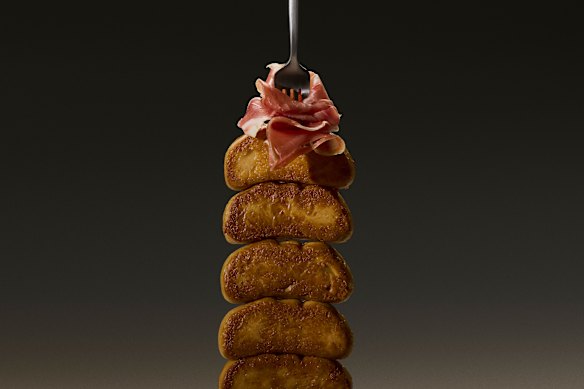Taste test: We try Australia’s new lab-grown foie gras alternative
By Dani Valent
Can lab-grown meat feed the planet and end industrial-scale animal farming? Australia recently took a small step towards this imagined future. On June 18, the country’s food regulator deemed a particular form of lab-grown meat – cell-cultured quail – as safe (lab-grown chicken has already been sold in Singapore).
To make the “quail”, Sydney start-up Vow submerges the cells in a “feeder” broth of amino acids, vitamins and sugar. They’re then transferred to stainless-steel tanks to multiply and, after 79 days, a paste is strained out. This pink goo is mixed with butter, shallots and brandy to make a parfait, and combined with fava bean protein and coconut oil to make lobes that resemble foie gras (pictured).

Lab-grown “quail”: “I’d put it in the category of ‘new and exciting food experience’, not large-scale product,” says adjunct biotechnology professor Paul Wood.
Good Weekend tries the “quasi-quail” at Melbourne’s Bottarga restaurant. Chef Federico Bizzaro pipes the parfait into a pastry cigar: the creamy paste is smooth and rich with a ferrous tang that replicates real chicken-liver parfait but, honestly, with that much butter, brandy and salt, you could flavour tofu and get a similar experience. Chef then cooks a beautiful wagyu eye fillet, sears the cultivated foie gras (a $30 supplement) in wagyu fat, stacks it on the steak and showers the whole lot in truffles. It’s a triple-decker luxury bomb and, as you’d expect, it’s delicious.
Traditional foie gras is a controversial delicacy produced by force-feeding ducks or geese so their livers enlarge. The resulting offal is subtle, creamy and oh-so-rich. “I wouldn’t serve it because the way they overfeed [the birds] isn’t nice,” says Bizzaro. “But if we can have the product without the ethical problems, then why not?”
I try the pretend version by itself: the substance breaks in the mouth like steamed custard rather than coating the palate.
Melbourne start-up Magic Valley positions its lab-grown meat as a solution to the protein needs of a growing global population and environmental concerns about meat production. The sustainability calculus is complex, though. A 2023 study by environmental research firm CE Delft suggested cultivated meat has a potential climate impact of 3-14 kilograms of carbon dioxide equivalent per kilogram of cultivated meat, compared with about 35 kilograms for conventional beef. But variables make comparisons difficult. The climate impact of carbon-positive, regenerative cattle-grazing in NSW is very different to a multi-storey pig farm in China, while a cultivated meat factory using renewable energy will have a lower impact than one that uses gas or coal.
“I’m sceptical that this is an answer for the protein needs of the world,” says Paul Wood, an adjunct professor of biotechnology at Monash University. “Vow is world-leading and believes it could produce 10 tonnes a month. The average butcher would turn over a tonne of meat in a few days. I’d put it in the category of ‘new and exciting food experience’, not large-scale product.”
Meanwhile, consulting firm McKinsey projected in 2023 that cultivated meat may achieve production-cost parity with conventional meat by 2030, making it a $US25 billion industry. “I see it like electric cars,” says Bizzaro. “You need people to buy it at the start to help them grow, experiment and drop the price over time.”
To read more from Good Weekend magazine, visit our page at The Sydney Morning Herald, The Age and Brisbane Times.